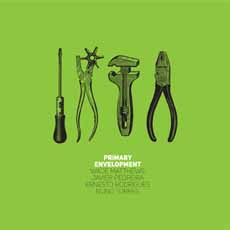
Ernesto Rodrigues - viola
Nuno Torres- alto saxophone
Javier Pedreira - guitar
Wade Matthews - digital synthesis, field recordings, amplified objects
cs286
Architecture is a common source of metaphor in the eternal and often thankless struggle to describe, capture, label or otherwise burden musical concepts with what almost invariably prove to be the most intractable substantiations of verbal taxonomy. It even creeps into some of the more fanciful forms of compositional technique, such as the idea of crafting a melody as the sonic (or at least, notational) reflection of an urban skyline—Villa-Lobos’ Symphony No. 2 comes to mind as a relatively recent example. Of course, architecture and composition do have much in common. At their best, both are forms of creative expression—at the very least, they are expressions of creativity, an idea not at all incompatible with Stravinsky’s Norton reflections—and, more appositely here, both are forms of planning.
Improvisation, however, is more like building. There is a hands-on aspect to it that involves sound matter, instrumentation, dialog and, especially, time, in ways that differ significantly from how they are interrelated in other musical processes, notably pencil-and-paper composition. So there is something truly refreshing in Robert Smithson’s comparison of building to architecture in his brilliant text, A Sedimentation of the Mind.
Building takes on a singular wildness as loaders scoop and drag soil all over the place. Excavations form shapeless mounds of debris, miniature landslides of dust, mud, sand and gravel. […] These processes of heavy construction have a devastating kind of primordial grandeur, and are in many ways more astonishing than the finished project—be it a road or a building. The actual disruption of the earth’s crust is at times very compelling, and seems to confirm Heraclitus’s Fragment 124, “The most beautiful world is like a heap of rubble tossed down in confusion.”
Perhaps I should remind the reader, here, to pay especial attention to Heraclitus’s use of the word “like” in the final sentence, lest someone think I am suggesting that improvised music is quite simply a heap of sonic rubble. Instead, I would invite the reader to visualize the activity, the sense of rhythm and energy, the cycles that manifest at different physical and temporal scales on a building site.
Another observation by Smithson also seems appropriate here: his response to McLuhan and others’ tendency to define tools in terms of their relation to the species best known for using them—the now long-established idea of the human body merging with tools to create a cyborg—rather than in terms of their actual constitution.
The manifestations of technology are at times less “extensions” of man (Marshall McLuhan’s anthropomorphism) than they are aggregates of elements. Even the most advanced tools and machines are made of the raw matter of the earth. Today’s highly refined technological tools are not much different in this respect from those of the caveman.
Indeed, a Neolithic flint scraper is no more and no less organic than the silicon holding my laptop together. In fact, the word silicon actually comes from the Latin silex, a name still applied to flint in French and some other Romance languages.
The four builders constructed the music on this CD with just such tools, excavating, shifting and listening as they generate innumerable cycles that cross and interact, establishing relations not all of which can be grasped in one or even ten listenings. The viola, saxophone, laptop computer and electro-acoustic guitar (Javier Pedreira quite rightly prefers to call it a “guitar”, with no need for adjectives or qualifiers) are all “highly refined” and each is an aggregate of earthly elements. With these tools, they build.
Here, of course, we have a CD, something Smithson would probably consider a sort of “non-site”, yet it is neither a road nor a building. Instead, it is the audible record of its own processes of construction—a primary envelopment.
Wade Matthews